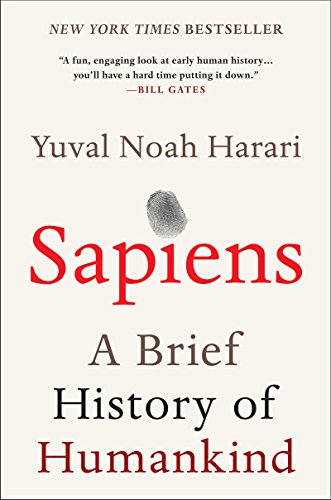

This article is an excerpt from the Shortform summary of "Sapiens: A Brief History of Humankind" by Yuval Noah Harari. Shortform has the world's best summaries of books you should be reading.
Like this article? Sign up for a free trial here .
The history of religion is vast. What are the main turning points in the history of religion? How has religion unified mankind? How has it divided us?
The history of religion starts with animism and progresses through the rise of polytheism, monotheism, and natural law religions. Each type of religion influenced the ones that came later, and today we see the legacies of them.
We’ll cover the history of religion from the animism of our forager ancestors to some of the most widespread religions today.
The History of Religion
Today, we often think of religion as something that divides rather than unites. Yet religion has a crucial role in supporting our other imagined orders, orders that have led to our success as a species.
Because the social orders on which our societies are founded are imaginary, they’re fragile. Religion’s role is to give “superhuman legitimacy” to these orders, making them hard to challenge. This makes social orders more stable.
Before we dive into the history of religion, let’s look at how researchers define “religion.”
Requirements of a Religion
But not all religions unify, and not all belief systems are religions. Let’s look first at the definition and requirements that make a belief system a religion, and then we’ll look at the additional requirements that give particular religions their unifying function.
To be a religion, a system has to meet two requirements:
- The system has to be predicated on the belief in a “superhuman” order. As used here, “superhuman” is defined as “not the product of human actions.” For instance, professional soccer shares a lot in common with religion: it contains rituals, rites, and laws. But because these rituals and laws are determined by humans (in this case, FIFA), professional soccer isn’t a religion.
- The system must establish norms and values, like modesty in dress or showing compassion. Many people believe in ghosts, but these beliefs don’t give us moral standards to meet, so they don’t constitute a religion.
The religions that revolutionized the world and led us toward a more global empire have two more requirements.
- The system must be universal. Believers must believe that their system is true everywhere and applicable to everyone. Below, we’ll look at how local religions like animism gave way to universal religions like Christianity.
- The system must be missionary. Believers must be fanatical about spreading the universal truth of their system to everyone on earth.
Religions that are both universal and missionary appear relatively recently in history. These religions have the power to bolster our imagined social orders and unify humanity on a grand scale.
The History of Religion: Animism
The history of religion begins with animism. Animism is a belief system in which all objects, animate or inanimate, have a soul. According to these religions, humans must consider the feelings and desires of rocks and mountains as well as plants and other animals.
Most religions of hunter-gatherers were animistic. These religions were local rather than universal. Hunter-gatherers typically didn’t travel far in their lifetimes, so they shaped their religion around their own particular territories. This meant that the religion of one forager band in the Ganges Valley might forbid the cutting down of a fig tree to keep the tree’s spirit from exacting revenge. The religion of a forager band in the Indus Valley might forbid the hunting of white-tailed foxes because once a white-tailed fox had led the band to an area abundant with obsidian.
Because they weren’t universal, these religions weren’t missionary. There was no reason for the Indus band to try to convince the people in the Ganges band not to hunt white-tailed foxes—the Ganges band didn’t have any stories or experiences related to the fox, and might not even have foxes in the area.
The Rise of Polytheism
Next in the history of religion comes polytheism. The Agricultural Revolution led to a religious revolution. In previous, animistic belief systems, man was no better than other animals, plants, and geographical features. For instance, man didn’t consider himself superior to a sheep just because he hunted sheep, just as he wouldn’t consider himself inferior to tigers just because they hunted him.
But when hunter-gatherers became farmers, suddenly man had dominion. Rather than equals in the spiritual realm, sheep and grains became objects farmers owned and protected jealously. Man and his concerns became the center of religious belief. This was an important stage in the history of religion.
While man suddenly had more control over the animal and plant kingdoms than he’d ever had before, his control wasn’t complete. He still had to contend with drought, epidemics, and sickly lambs. He could no longer pray and make offerings to the ewe to have healthy lambs, as he could have in an animate religion, because the ewe was now his property and theoretically under his control. You don’t pray to something less powerful than you are. Man had to find someone or something else to worship, someone to control the things he couldn’t.
Gods originated as a way to solve this problem. The job of gods was to mediate between humans and the rest of the natural world, over which man now wanted control. Humans worshipped gods in return for dominance over plants and animals.
As empires and trade networks grew, the worlds of individuals got larger. Rather than appealing to a few local gods, people now needed a pantheon that could address all the new needs of an expanded world. This was the origination of polytheism, the belief in many gods. Gods usually had distinct personalities and functions. For example, there was a goddess to address infertility, a god to make it rain, and a god to bring luck in war.
Although polytheism came to dominate the religious landscape, animism didn’t disappear. As we’ll see, legacies of animistic belief remain today. What did disappear was the belief that humans were just one among many beings with souls. Polytheism brought man center stage and changed the way we viewed ourselves and our world.
The Inherent Tolerance of Polytheism
Tolerance is an important issue in the history of religion. Although it may have downgraded the status of plants and fellow animals, polytheism was remarkably tolerant of other religions, a feature we don’t see as often with monotheistic religions, which promote belief in a single god.
Polytheism’s plurality of gods made it tolerant by nature. Since they already believed in the existence of many gods, it wasn’t difficult for people to believe that another god existed and was effective at meeting the needs of another group of people.
Rulers of polytheistic empires didn’t try to convert their conquered subjects. For example, the Egyptians, Romans, and Aztecs asked that their new subjects respect their gods (since these gods were the foundation of the empire, holding up the imaginary social order), but they allowed them to continue worshipping their local gods as well. In some cases, the rulers added gods of conquered peoples to their own pantheon. For example, the Romans adopted the goddess Cybele from Anatolia, and the goddess Isis from Egypt.
The Rise of Monotheism
Monotheism is the aspect of the history of religion that we’re most familiar with. Over time, some polytheistic worshippers became particularly fond of one deity over the others and eventually started worshipping only that deity. This was the origin of monotheistic religions.
This single god retained the biases and interests of the polytheistic gods. Unlike the supreme powers of polytheism, who were impersonal and uninterested in the lives of humans, monotheism’s supreme powers had personalities and took an active role in the human world. This meant people could negotiate with God, praying to Him and providing offerings. You can only negotiate with a divine being if that divine being has biases and can intervene in the human world.
The first monotheistic religions, like the worship of Aten in Egypt and early Judaism, failed to spread because they weren’t universal. For instance, the Jewish God was only interested in Israel and the Jewish people, so Judaism didn’t have much to offer people of different ethnicities who lived outside of Israel.
Christianity, however, had growing power. It was the first missionary religion in the history of religion. Christians believed that their incarnated supreme power had died on the cross for the sins of all humans, making this a religion applicable to everyone. Paul of Tarsus, one of the first leaders of what was then a Jewish sect, believed everyone should know the gospel, the good news that Jesus had died for their salvation. So Christianity was both universal and missionary, meeting the requirements of a revolution-inciting religion.
The Benefits of Intolerance
Again, tolerance is a primary issue in the history of religion. Monotheism is inherently less tolerant than polytheism. If you only believe in one god, and believe that this god is the supreme power of the entire universe, you can’t also believe in the existence of another religion’s god. Your god has to be the only god. Therefore, in order to convert others to your religion, you need to discredit all the other gods and the religions built around them. This belief in one truth has made monotheists far more fervent in spreading their truth, discrediting other religions, and converting non-believers around the world.
Monotheism’s lack of tolerance, ironically, allowed it to spread and take over. In the first century AD, there were few monotheists. By the 16th century, monotheistic religions dominated most of Europe, Asia, and Africa. Today, almost everyone outside of East Asia practices a monotheistic religion, and our global imagined political order is bolstered by monotheism.
Natural Law Religions
Natural Law religions also have an important place in the history of religion. Although we tend to think of the belief in a god or gods as a requirement for a system of thought to be a religion, it’s not. Jainism, Buddhism, Confucianism, and Epicureanism, among others, don’t place importance on gods or a supreme being, although, for the most part, they don’t deny the existence of gods, either. These religions are based on natural laws rather than the laws of gods.
For example, the most popular natural law religion is Buddhism, whose central figure isn’t a god but a person, Siddhartha Gautama, the Buddha. The natural law in Buddhism is that suffering is caused by “the behavior patterns of one’s own mind” rather than the whims of gods and goddesses. If you learn to see pleasure and pain as mere sensations, neither good nor bad, you lose your attachment or aversion to them. This eradicates suffering. You still feel pain or pleasure, but they don’t cause suffering.
Non-Theistic Religions
As outlined at the beginning of this article, a system need only meet two criteria to be a religion: it needs to be based on the belief in a superhuman order and it needs to establish norms and values. By this definition, there are many other religions in the history of religion, some we don’t normally think of as religions, such as capitalism, Communism, and Nazism.
Further, these religions meet the 3rd and 4th criteria that give a system power to legitimize political orders and change history. These religions are both universal and missionary.
For instance, like Buddhism, Communism is a religion based on natural laws. In the case of Communism, these laws were discovered not by the Buddha but by Marx, Engles, and Lenin. Communism’s holy book is Marx’s Das Kapital and its holidays are the First of May and November 7th, the anniversary of the October Revolution. Devout Communists have been expected to give up faith in other religions, such as Christianity, and spread the gospel of Marx and Lenin. When viewed this way, Communism is a religion just as much as Buddhism or Christianity are.
———End of Preview———

Like what you just read? Read the rest of the world's best summary of "Sapiens" at Shortform . Learn the book's critical concepts in 20 minutes or less .
Here's what you'll find in our full Sapiens summary :
- How Sapiens outlived and outlasted the 8+ other human-like species on Earth
- The 3 critical revolutions in human existence that led to our domination of the planet
- How much of what powers our world today is really just a shared mass delusion
- What the future of humanity might look like






